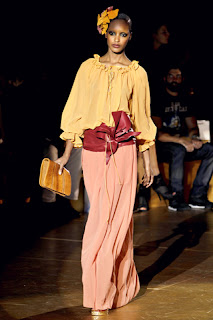
Next spring the Victoria & Albert Museum in London will open the first UK solo exhibition celebrating the life and work of Yohji Yamamoto, one of the world's most influential and enigmatic fashion designers. This installation-based retrospective, taking place 30 years after his Paris debut, will feature over 80 garments spanning Yamamoto’s career. The exhibition will explore the work of a designer who has challenged, provoked and inspired the fashion world.
Yamamoto’s visionary designs will be exhibited on mannequins amongst the treasures of the V&A. Placed in hidden corners of the Museum, the silhouettes will create a direct dialogue between Yamamoto’s work and the different spaces in which they are displayed.
The exhibition will be designed by Yamamoto's long-time collaborator, scenographer and lighting designer Masao Nihei. The main exhibition space will see over 60 garments from Yamamoto’s womenswear and menswear collections accompanied by a mixed-media timeline showing excerpts from his fashion shows, films and performances, graphic material and select photographs which will contextualise his career. Following Yamamoto’s previous solo exhibitions, this UK retrospective will exhibit items from his menswear collections for the first time.
Yohji Yamamoto was born in Tokyo in 1943 and trained at Keio University then Bunka Fashion College. By 1972 he set up his own company, Y’s Incorporated. From the start of his career Yamamoto’s work was recognised for challenging the conventions of fashion. The asymmetric cuts and seemingly unflattering curves of his early work contradicted the close-fitted styles of the catwalks and he has refused traditional norms of fashion ever since.
Yamamoto’s designs have rewritten notions of beauty in fashion, and the playful androgyny of his work creates new modalities of gender identity. His collections are recognised for subverting gender stereotypes and have featured women wearing garments traditionally associated with menswear. Yamamoto's fabrics are central to his design practise and are a trademark of his work. Supporting craftspeople in and around Kyoto, his textiles are created to specification often employing traditional Japanese dyeing and embroidery techniques such as Shibori and Yu-zen. The selection of works on show will give visitors the opportunity to study examples of Yamamoto’s application of traditional Japanese techniques.
The exhibition will also record the breadth of some of Yamamoto’s key collaborations achieved through his career. Partnerships with fashion photographer Nick Knight, graphic designer Peter Saville, art director Marc Ascoli, choreographer Pina Bausch and filmmakers Takeshi Kitano and Win Wenders amongst many others, will be represented by a mixed-media timeline in the main exhibition space, and will demonstrate an important, creative dialogue which flows through his work.
















































